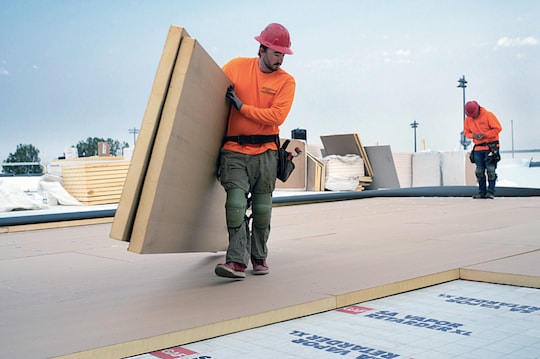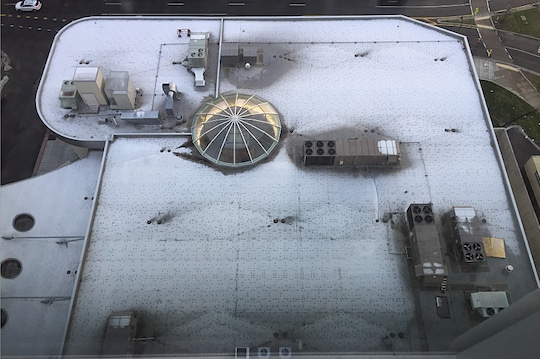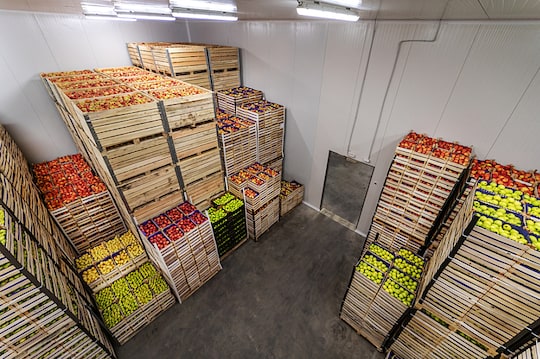
Comment est-ce que les assemblages de toitures contribuent à l’efficacité énergétique, la robustesse, et les objectifs de durabilité d’un bâtiment? La selection intentionnelle des matériaux augmentera la robustesse de l’assemblage y compris la capacité de survivre à une tempête, une isolation adéquate aidera à maintenir les températures intérieures et faire des économies énergétique, et les matériaux plus durables peuvent tenir plus longtemps ayant pour résultat des remplacements moins fréquents. Les assemblages de toitures hybrides sont la dernière tendance en matière de toitures visant à atteindre ces objectifs, mais est-ce qu’elles sont à la hauteur du matraquage?
What is a hybrid roof assembly?
A hybrid roof assembly is where two roofing membranes, composed of different technologies, are used in one roof system. One such assembly is where the base layers consist of asphaltic modified bitumen, and the cap layer is a reflective single-ply membrane such as a fleece-back TPO or PVC. Each roof membrane is chosen for their strengths, and together, the system combines the best of both membranes. A hybrid system such as this has increased robustness, with effectively two plies or more of membrane.
Asphaltic membranes, used as the first layer, provide redundancy and protection against punctures as it adds overall thickness to the system. Asphaltic systems, while having decades of successful roof installations, without a granular surface may be vulnerable to UV exposure, have minimal resistance to ponding water or certain chemical contaminants, and are generally darker in color options as compared to single ply surfacing colors choices. The addition of a single-ply white reflective membrane will offset these properties, including decreasing the roof surface temperatures and potentially reducing the building's heat island effect as they are commonly white or light in color. PVC and KEE membranes may also provide protection where exposure to chemicals is a concern and generally hold up well in ponding water conditions. The combination of an asphaltic base below a single-ply system increases overall system thickness and provides protection against punctures, which are primary concerns with single-ply applications.
Pictured Above: EverGuard® TPO 60‑mil Fleece‑Back Membrane
Millennium Hurricane Force ® 1-Part Membrane Adhesive
Millennium Hurricane Force ® 1-Part Membrane Adhesive
Isolation en polyiso EnergyGuardMC
Millennium Hurricane Force ® 1-Part Membrane Adhesive
Platelage en béton
Pictured Above: EverGuard® TPO 60‑mil Fleece‑Back Membrane
GAF LRF Adhesive XF (Splatter)
Fixations et plaques Drill-TecMC
Isolation en polyiso EnergyGuardMC
Isolation en polyiso EnergyGuardMC
Retardateur de diffusion de vapeur SA XL de GAF
Platelage en métal
Where are hybrid roof assemblies typically utilized?
Hybrid roof assemblies are a common choice for K-12 & higher education buildings, data centers, and hospitals due to their strong protection against leaks and multi-ply system redundancy. The redundancy of the two membrane layers provides a secondary protection against leaks if the single-ply membrane is breached. Additionally, the reflective single-ply membrane can result in lower rooftop temperatures. The addition of a reflective membrane over a dark-colored asphaltic membrane will greatly increase the Solar Reflectance Index (SRI) of the roof surface. SRI is an indicator of the ability of a surface to return solar energy into the atmosphere. In general, roof material surfaces with a higher SRI will be cooler than a surface with a lower SRI under the same solar energy exposure. A lower roof surface temperature can result in less heat being absorbed into the building interior during the summer months.
Is a hybrid only for new construction?
The advantage of a hybrid roof assembly is significant in recover scenarios where there is an existing-modified bitumen or built-up roof that is in overall fair condition and with little underlying moisture present. A single ply membrane can be installed on top of the existing roof system without an expensive and disruptive tear-off of the existing assembly. The addition of the single-ply membrane adds reflectivity to the existing darker colored membrane and increases the service life of the roof assembly due to the additional layer of UV protection. Additionally, the single-ply membrane can be installed with low VOC options that can have minimum odor and noise disturbance if construction is taking place while the building is occupied.
Is the hybrid assembly hype worth it?
Absolutely! The possibility to combine the best aspects of multiple roofing technologies makes a hybrid roof assembly worth the hype. It provides the best aspects of a single-ply membrane including a reflective surface for improved energy efficiency, and increased protection against chemical exposure and ponding water, while the asphaltic base increases overall system waterproofing redundancy, durability and protection. The ability to be used in both new construction and recover scenarios makes a multi-ply hybrid roof an assembly choice that is here to stay.
Interested in learning more about designing school rooftops? Check out available design resources school roof design resources here. And as always, feel free to reach out to the Building & Roofing Science team with questions.
This article was written by Kristin M. Westover, P.E., LEED AP O+M, Technical Manager, Specialty Installations, in partnership with Benjamin Runyan, Sr. Product Manager - Asphalt Systems.


